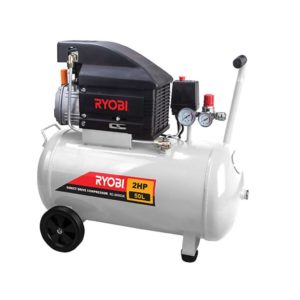Compressors
Showing all 7 results
-

RYOBI RC-1500 Air Compressor, 1.5HP (1.1W) (No Tank)
R1,455.00 -

RYOBI RC-1524D Direct Drive Compressor, 24L, 1.5HP (1.1kW)
R1,799.00 -

RYOBI RC-2050NV Air Compressor, Oil Free, Vertical Mount, 50L (1.5W)
R2,865.00 -

RYOBI RC-2055DK Direct Drive Compressor,50L with 5 Piece Kit (1.5kW)
R2,645.00 -

RYOBI RC-3050T Air Compressor, Twinhead, 50L, 3HP, (2.2kW)
R4,515.00 -

RYOBI RC-3100B Air Compressor, Belt Drive, 100L, 3HP ( 2.2kW)
R8,319.00 -

RYOBI RC-3150B Air Compressor, Belt Drive, 150L, 3HP (2.2kW)
R9,015.00
Compressor (air compressor) – a device for compressing and supplying air under pressure. Compressed air is used for many tasks, including for:
- pneumatic tool work;
- inflation of tires, inflatable boats and pools;
- cooling;
- gas station of high-pressure gas cylinders;
- car wash.
In addition, compressors are widely used in all areas of production.
By design type, the following compressors are distinguished:
- piston;
- screw.
In turn, pistons are divided into oil and oil-free. Oil compressors are optimal for pneumatic tools. They have a large resource of work – up to 5 thousand hours, but supply air with an admixture of oil. To obtain clean air, oil-free compressors are used. They are in demand in medicine, pharmaceuticals, and in everyday life – for painting work. Their service life is shorter compared to oil compressors.
Screw compressors are industrial. They have high performance, can work around the clock and have a large working resource.
By type of drive, compressors are:
- coaxial (with direct drive) – productive, but less reliable;
- beltless overheat and last longer, but performance is lower.
Depending on the outlet pressure, there are 3 types of compressors:
- low pressure (5-12 bar);
- medium pressure (30-50 bar);
- high pressure (150–300 bar).
For domestic needs, it is enough to buy a low-pressure compressor. When choosing, pay attention to the following parameters:
- power (from 800 to 4000 W and above);
- productivity (average 150–500 l / min);
- maximum outlet pressure (for household models: 5–13 bar);
- receiver volume (from 6 to 500 l and higher for professional models);
- work resource.







